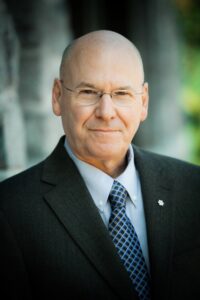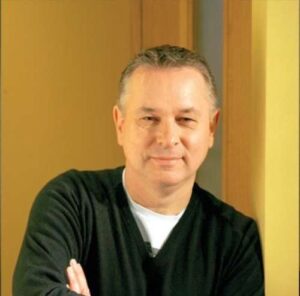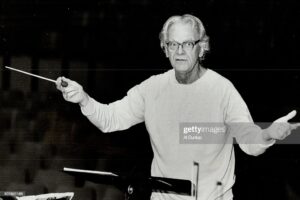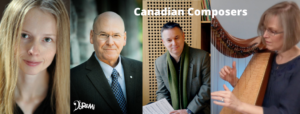One of the ways in which we try to inspire the love of music in our students, is to allow them to pick their own songs from the RCM repertoire. We understand that it’s hard to practise a song that you don’t like, and then it becomes hard to practise at all! Letting them pick their own songs also encourages them develop their own sense of style and to gain an understanding of the types of music that they enjoy playing.
Over the years, we have found that there are a number of composers that the students gravitate towards. Many of these composers are Canadian, and although the kids love their songs, they know very little about them. This is what we found out about a few of our favourites:
Christine Donkin (b. 1976)
 Christine Donkin was born in Grande Prairie, Alberta. She studied at the University of Alberta and the University of British Columbia.
Christine Donkin was born in Grande Prairie, Alberta. She studied at the University of Alberta and the University of British Columbia.
She is an award-winning composer, writing music in a wide range of styles for a broad range of listeners and performers. While her compositions have been heard at such prestigious venues as Carnegie Hall and the Moscow Conservatory, they are often frequently played at concerts featuring music students, community orchestras and church choirs.
Christine says that she never really discovered music, but that it was “unavoidable” in her house, where both her parents were musicians and teachers. She started composing at the age of 5 (with her parents writing it down for her), and by 17 was winning composition competitions with works ranging from choral to orchestral, and everything in between.
She notes that, for her, harmony is the most fascinating aspect of music and the springboard for most of her work. She doesn’t mean it simply in the traditional sense. She is intrigued by the emotional impact that any 2 or more notes put together can have on the listener.
The music she writes has influences drawn from poetry, paintings, and many visual things such as “clouds”. Many of her compositions start to take form in her head while she is out on long walks.
Over 100 of her pedagogical compositions, arrangements and figured bass realizations appear in the Royal Conservatory of Music graded repertoire and studies books. A couple of favourites among our students are Witches and Wizards level 3, and Peace Country Hoedown level 7.
Here, the Toronto Symphony Orchestra plays one of her compositions, Hopewell Cape.
Stephen Chatman (b. 1950)
 Stephen Chatman is one of Canada’s most prominent composers. He can be found at the University of British Columbia where he is professor of composition. orchestrations, co-director of the UBC Contemporary Players new music ensemble, and head of the composition division of the Department of Music. From there, he has taught a generation of prominent Canadian composers.
Stephen Chatman is one of Canada’s most prominent composers. He can be found at the University of British Columbia where he is professor of composition. orchestrations, co-director of the UBC Contemporary Players new music ensemble, and head of the composition division of the Department of Music. From there, he has taught a generation of prominent Canadian composers.
Dr. Chatman has won numerous awards for his compositions, including multiple Juno nominations. He is known internationally for his choral, orchestral and piano music. In 2003, he was on of three Canadian composers to visit Beijing and Shanghai in the “First Exchange of Canadian and Chinese Composers” sponsored by the Chinese Musician’s Association. In 2012, Dr. Chatman was appointed a Member of the Order of Canada.
He has several pieces available in the RCM piano series. Some of the ones we love include:
Spring Light, Echoes of November, Jazzberry Jump, Katherine, and Sneaky
Anne Crosby Gaudet (b. 1968)
 Anne Crosby Gaudet is a music educator, composer, and independent publisher from Nova Scotia. Her Music Discoveries Shop specializes in both piano and harp music. We love her material here at the school. Some of our favourite piano pieces include Freddie the Frog, Starfish at Night, Robots, Angelfish, Funny Puppy, Dreamcatcher, and Dragonfly Scherzo.
Anne Crosby Gaudet is a music educator, composer, and independent publisher from Nova Scotia. Her Music Discoveries Shop specializes in both piano and harp music. We love her material here at the school. Some of our favourite piano pieces include Freddie the Frog, Starfish at Night, Robots, Angelfish, Funny Puppy, Dreamcatcher, and Dragonfly Scherzo.
These pieces that we love so much were originally written for her own students, fuelled by her desire to have music filled with teachable moments. She wanted to incorporate the things that they were learning, such as 5-finger patterns, intervals, chromatic scales, and whole tone scales, into music that inspired the imagination and used the full range of the piano to create an impressive sound.
Anne started composing as a child, encouraged both by her first piano teacher and by her family. She completed her Masters degree in Piano Pedagogy and Performance at the University of Michigan, and then went home to Nova Scotia to open her own studio.
According to Anne, composition starts with inspiration and imagination, and then takes time and work. In this video she shares with us the process of creating and recording a song for the harp:
One of the questions that often comes up when we are working on a piece, is “what do you think was in the composer’s head when they created this …. How do you think they would want it to sound?” Our students love the fact that they can find YouTube videos of Anne playing her own compositions.
Christopher Norton (b. 1953)
 Although originally from New Zealand, Christopher Norton now resides in Stratford Ontario.
Although originally from New Zealand, Christopher Norton now resides in Stratford Ontario.
Norton’s interest in music, especially classical music, was evident at a very early age. He completed an honours degree in music, and then started his career as a music teacher in Wellington high schools. He became interested in a wide range of musical styles, and quickly turned his hand to composing and arranging.
Christopher Norton began composing at the age of 14, and by the time he was 16, he had already had an orchestral work performed and broadcast. Now a well-established composer, producer, arranger and educationalist, he has written stage musicals, ballet scores, piano music, popular songs and orchestral music as well as jingles and signature tunes for TV and radio. He is probably best known, however, for his Microjazz series, first published by Boosey & Hawkes in 1983. It is one of the most widely used educational series ever published.
In 2007, Frederick Harris Music published Christopher Norton Connections for Piano, a collection of 180 new, original pieces in popular styles. The pieces are divided into graded books that correspond to the RCM grades. Some of our favourites include:
The Highlands, In the Spirit, Positively Swinging, Scamp, Mississauga Rag, Fantasy Bossa, and Jane’s Song.
All of these pieces have backing tracks, and many of them are featured in educational videos on his website.
Clifford Poole (1916-2003)
 Clifford Poole was born in England, and emigrated to Canada with his family when he was young. They settled in Toronto where he studied piano and began performing. His wife, Margaret Parsons, was also a composer and pianist, and together they toured Canada and the US.
Clifford Poole was born in England, and emigrated to Canada with his family when he was young. They settled in Toronto where he studied piano and began performing. His wife, Margaret Parsons, was also a composer and pianist, and together they toured Canada and the US.
Although he loved to perform, he was also a great teacher. He taught at the Royal Conservatory, at Western University, and at the University of Toronto. Piano was his main focus, but he also became interested in orchestra. He wrote compositions which were performed by the East York Symphony Orchestra, and served as conductor for several orchestras in the Toronto area.
Together with his wife, he composed, compiled, and edited a great deal of music for young players, many of which are featured in the RCM curriculum. We especially like Spooks, Mist, and Nocturne

